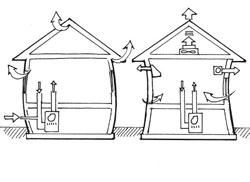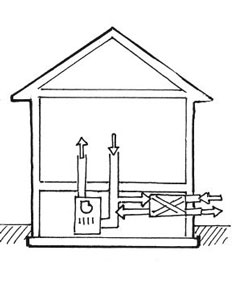Signs That You May Have an Air Quality Problem
Just like our bodies, houses will present symptoms that help us diagnose when the system isn’t working properly. The main problems to diagnose are excess infiltration (through walls or ducts), inadequate air exchange (too little ventilation), and excess moisture. Often, excess moisture speaks for itself. If you see condensation, mold, or excessive ice buildup, you know you have a problem. (See the section “Control moisture.”)
Signs of Excess Infiltration
Excess air infiltration often leaves characteristic “fingerprints” that can be read or felt. Most obvious is when you feel a draft, particularly in winter and especially when you are closer to exterior walls. One less obvious sign of infiltration is frequent static electricity discharges in winter due to indoor humidity levels that are too low. Also look for “ghost” tracks of dark dust near boundaries that are poorly sealed. These tracks are most common on light carpets near exterior walls, and as black edges on fiberglass insulation batts between joists in the attic. What is happening is that dusty air is moving through the wall and dropping the dust when it reaches the wall and its velocity slows.
If you have air conditioning and heating equipment in the attic, your ductwork is very likely the cause of infiltration, and you should seal and insulate the ducts accordingly. Otherwise, the best way to address excess infiltration is to seal obvious leaks in your windows, walls, and connections between your house and your attic, as described in the building envelope section. If you are unsure of how to find leaks, hire a contractor to conduct a blower-door test to identify and seal them.
Signs of Inadequate Air Exchange
Odors can be very good indicators of too little ventilation and may also reveal how air travels through your house. How persistent are certain odors? Where are they generated and where are they getting trapped?
If odors persist for hours, it is because either the source keeps on releasing the chemicals we smell, or the air carrying the odors does not have a quick, controlled way out of the house (if your house contains a lot of cloth furnishings, they will also trap odors). It can be instructive to think through what it means when some strong odor does or does not percolate through the house. Consider the onions frying in the kitchen.
If that odor doesn’t reach the rest of the house, this may mean that kitchen ventilation is working very well. In this case, there should be relatively little onion fragrance in the kitchen, too. But what if the kitchen proclaims, “Onions cooking,” but no one notices in the far bedrooms? That would suggest that air is not circulating throughout the house very effectively.
Signs of Too Much Air Exchange
If you live in a dry climate (or a place with cold, dry winters), and it is uncomfortably dry inside, check the fan speed on any ventilation equipment you might have installed before running out to buy a humidifier. Likewise, if you live in a hot, humid climate, high ventilation rates can increase indoor humidity beyond what the air conditioner can control on its own, requiring supplemental dehumidification.



